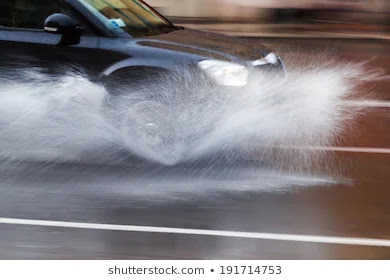Eight Tips For Driving When The Rain
Tips For Driving When The Rain
First off, lets examine why driving in the rain is different. There are four main differences that require special attention and techniques:- Car tires have much less grip in the rain. This causes a variety of problems including increased stopping distance, less cornering capability, and the potential for aquaplaning. This is an area typically not covered in driver's education because the car's capabilities vary so greatly.
- Vision can be greatly impaired while driving in the rain, especially during a heavy rain storm and at night.
- Many people are clueless, even in areas where is rains often. This represents additional danger as it becomes less likely drivers will react properly and reliably.
- Road conditions vary dramatically. Even within your own lane there are large differences in road grip. So, whether you live in a rainy area like Seattle or in the deserts of Arizona it is important to remember the following collection of 9 tips when driving in the rain.
- Check your equipment. Driving in difficult conditions means relying more heavily on your car's equipment, including tires, wipers, and lights. Check your tires once a month to ensure the tread depth is adequate. Make sure your tires are properly inflated per your owners' manual.
- Turn on your lights. It is a good practice to turn on your headlights when driving in the rain as it can increase your vision but more importantly make your car easier to see by other drivers. Also, in some states like New York the law requires drivers to turn on their lights when it is raining.
- Slow down. Cars react slower in the rain as the tires have less grip. It will take longer to stop and the car cannot go as fast through a turn and maintain a healthy grip level. Just keep in mind that emergency maneuvers will simply take longer to execute in the rain.
- Maintain a larger gap. Given that it takes longer to stop and visibility is decreased, leaving a larger gap between you and the car ahead is required. Remember that it takes longer to stop in the rain so the additional space will be needed.
- Avoid aquaplaning. As taught in driver's ed, aquaplaning occurs when water separates your tires from the road. The worst cases of aquaplaning can be likened to driving on ice where there is very little grip. Do not drive through deep puddles of water and avoid situations where you need to drive through standing water at a high rate of speed.
- Properly recover from a skid. Given a lack of grip, there is a higher probability that you may enter a skid at some point when driving in the rain. Most driver's education courses get this one wrong, so beware. The easiest way to recover from a skid is to look in the direction you want to go and steer the car in that direction. Forget about steering into a skid, etc. as this is much too complicated to remember in the moment you are in a skid.
- Drive in previous car tracks. Let the car ahead of you "plow the road", so to speak. Their tracks are where the water level will be minimal as the car in front has already moved away from where your tires will be travelling. Driving in the previous car's tracks will lessen the chance of aquaplaning and provide better grip in general.
- Road is slippery after the first rain. This is definitely taught in all driving courses and is very important to remember. Many a driver has forgotten this rule and paid the price. When it first starts to rain, oils that have accumulated in the road float to the surface making the conditions even more treacherous.

